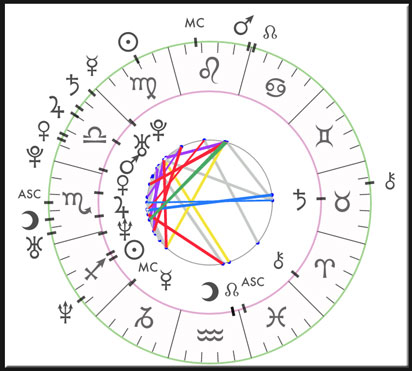

How to read both charts for synastry
• Analyze the original Mercury, Sun, Venus, Moon, and Mars compatibility on an elemental basis.
• Analyze each persons’ chart individually to deduct their needs in a relationship:
• Study the 7th house in detail. Also, study the ruler of the 7th house and planets in it.
• Study the Venus—the house, the aspects, and the sign
• Study the Mars—the house, the aspects, and the sign
• Check out the conjunctions between person A’s chart and person B’s chart
• Look where the planets fall of person A fall in person B’s chart and vice versa, for example, where does person A’s Saturn falls in person B’s chart?
• Combine both the charts and look for composite charts.
Important Planets and Luminaries
In synastry, the interaction of the Moon, Venus, Mars, Sun, and the Ascendant of each individual is important to determine compatibility between both the charts through planets. The Sun and Ascendant are responsible for the initial attraction between the two individuals. The placement of the Sun determines the personality of an individual. Meanwhile, Ascendant shapes the visible behavior of a person.
The interactions of the Moon, Venus, and Mars between two individuals are what determines whether the initial attraction can be taken to the next level or not. The placement of the Moon in the birth chart of an individual determines how a person reacts to situations and their emotional level. Their reaction is an important aspect of the success or failure of a relationship. Meanwhile, Venus is the ruler of preferences of a person with regards to attraction. It is those specific standards we have set to determine who our partner shall be and who is our type to date. Mars, on the other hand, determines the sexual compatibility of two individuals.
If the aspects between Venus and Mars are harsh, the sexual attraction between individuals is high. However, the relationship will also be challenging and full of obstacles. Saturn/Moon aspects are more strong to denote a strong sexual attraction.
Aspects
Aspects are the conjunctions between two or more planets in the charts of the individuals. Aspects can be stressful as well as smooth. They can be devastating or stabilizing. However, conjunctions cause issues when two people are too alike. It is because boredom ensues in the relationship and the couple takes each other for granted.
Trine (Planets form a 120 degrees angle)
• The positive of the all-other aspects in synastry.
• Brings smoothness to relationship but boredom too.
• The relationship lacks passion over time.
Sextile (Planets form a 60 degrees angle)
• The couple forms a good and long bond.
• Smooth relationship.
• Similar to trine but does not cause boredom as two people are different.
Square (Planets form a 90 degrees angle)
• The aspect ensues a lot of tension.
• The partners try to dominate each other.
• If such aspects are numerous in both charts, tensions will ensue.
Oppositions (Planets form a 180 degrees angle)
• Oppositions push the couple to grow together.
• The attraction between the couple is like magnetism.
• However, despite the attraction, communication is not enough.
Quincunx (Planets are within a 1 degree to 2 degrees orbit)
• The energies of these planets fail to interact smoothly and cause drama in a relationship.
• In extreme forms, bickering and arguing are high.
Houses
The interplay of planets in the 1st, 5th, 7th, and 8th houses of both individuals is important to analyze in synastry. If any of your planets fall in your partner’s 1st, 5th, 7th, or 8th houses, a sole level of intimacy exists between you too. However, we will have to look further, what importance each house holds in synastry and what does it mean to have planets in any of these.
1st House (Ascendant)
1st House is the ruler of personality and appearance. If your planets fall in another person’s first house, it means that attraction exists between you too or that you have an attraction for them. Also, there looks appeal you.
5th House
5th House is the ruler of romance, play, and pleasure. If numerous planets exist in either your or your partner’s fifth house, you both enjoy each other’s company and have similar likes and dislikes. The friendship between you two is strong.
7th House (Descendant)
The seventh house is the house of official commitment, which is marriage. If your planets occupy your partner’s seventh house and vice versa, you guys will marry one day. However, if planets in your partner’s seventh house are inactive, they won’t marry you. Meanwhile, if they are partially active, your partner will marry you, but not yet.
8th House
The eighth house is the ruler of an intimate relationship. If your planets occupy your partner’s house or vice versa, you two have a strong sexual desire for each other. Also, if you have your planets in your partner’s eighth house, you might have an urge to control them or indulge in obsessive behavior.